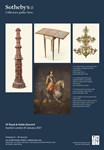It is common practice in the antiques trade to price stock/inventory with a price which the business is usually happy to reduce. I do not subscribe to this practice. I am sorry, but I don’t.
While television programmes advise customers to ‘haggle’ for reduced prices for antiques, it does create problems which the trade does not need to condone. Nor should it. If the price is not to be taken seriously, what about the descriptions? Or the business integrity of the dealer?
The antiques trade has enough problems with allegations of selling fakes and with newspaper and television reports of ‘over
restoration’ and ‘improvement’. It does not need to compound the mistrust by meaningless price tickets.
When I buy something for my business, I take price very much into consideration, because I want to hand good value and genuine antiques on to my customers. If I were to inflate the price by 20-30% because of an anticipated reduction at the point of sale, and the buyer then does not ask for a reduction, they will have paid too much. This would do nothing for my reputation.
The whole business of selling antiques is made much simpler and more transparent if marked prices mean what they say, and this is where we stand on the issue. Others may play mind games with prices, but this sort of uncertainty we would prefer to leave in the auction room.
Why, oh why, don’t dealers say what they mean?
Robin Butler
Butler’s Antiques








